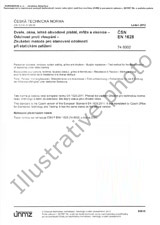We need your consent to use the individual data so that you can see information about your interests, among other things. Click "OK" to give your consent.
ČSN ETSI EN 302065-2-V2.1.1 (875141)
Short Range Devices (SRD) using Ultra Wide Band technology (UWB); Harmonised Standard covering the essential requirements of article 3.2 of the Directive 2014/53/EU; Part 2: Requirements for UWB location tracking
Translate name
STANDARD published on 1.4.2017
The information about the standard:
Designation standards: ČSN ETSI EN 302065-2-V2.1.1
Classification mark: 875141
Catalog number: 501770
Publication date standards: 1.4.2017
SKU: NS-678897
The number of pages: 40
Approximate weight : 120 g (0.26 lbs)
Country: Czech technical standard
Category: Technical standards ČSN
The category - similar standards:
Annotation of standard text ČSN ETSI EN 302065-2-V2.1.1 (875141):
V2.1.1
The present document applies to transceivers, transmitters and receivers utilizing Ultra WideBand (UWB) technologies and used for location tracking purposes.
The present document applies to impulse, modified impulse and RF carrier based UWB communication technologies.
The present document applies to fixed, mobile or portable applications, e.g. the present document applies to the following equipment types:
- - stand-alone radio equipment with or without its own control provisions;
- - plug-in radio devices intended for use with, or within, a variety of host systems, e.g. personal computers, hand-held terminals, etc.;
- - plug-in radio devices intended for use within combined equipment, e.g. cable modems, set-top boxes, access points, etc.;
- - combined equipment or a combination of a plug-in radio device and a specific type of host equipment.
The present document applies to UWB equipment with an output connection used with a dedicated antenna or UWB equipment with an integral antenna.
The present document covers three different types of location tracking system, which may use either of the UWB technologies listed previously:
- - LT1 systems: These systems, operating in the 6 GHz to 9 GHz region (see CEPT Report 45 [i.13]), are intended for general location tracking of people and objects. They operate on an unlicensed basis. The transmitting terminals in these systems are mobile (indoors or outdoors), or fixed (indoors only). Fixed outdoor LT1 transmitters are not permitted. Typically, LT1 transmitters are mobile location tracking tags which are attached to people or objects, and tags are tracked using a fixed receiver infrastructure to only receive the UWB emission emitted by the tags, ETSI EG 201 399 [i.1].
- - LT2 systems: These systems, operating in the 3,1 GHz to 4,8 GHz region (see ECC/REC(11)09 [i.8]), are intended for person and object tracking and industrial applications at well-defined locations. The transmitting terminals in these systems may be located indoors or outdoors, and may be fixed or mobile. They operate at fixed sites and may be subject to registration and authorization, provided local coordination with possible interference victims has been performed, ECC Report 167 [i.10] and ECC Report 170 [i.11].
- - LAES systems: These systems, operating in the 3,1 GHz to 4,8 GHz region (see ECC/REC(11)10 [i.9]), are intended for tracking staff belonging to the fire and other emergency services, who need to work in dangerous situations. Being able to track such people, even when deep inside a building, provides an important enhancement to command and control and to their personal safety. Typically, an LAES system is deployed temporarily at the scene of a fire or other emergency in a building. Licences may be required for user organization, ECC Report 167 [i.10] and ECC Report 170 [i.11].
Some individual location tracking devices may be able to operate within different kinds of location tracking systems, and therefore may meet (in different modes) the requirements of any or all of LT1, LT2 and LAES.
The present document does not cover UWB transmitters whose authorization to operate depends solely on the tests set out in the present document and which are installed or used in flying models, aircraft and other forms of aviation. Furthermore, it does not cover LT1 UWB transmitters that are operated on board a road or rail vehicle running on a public network or highway.
The permitted frequency ranges of operation for the various device types covered by the present document are given in table 1
Preview of the standard ČSN ETSI EN 302065-2-V2.1.1 (875141)
We recommend:
Technical standards updating
Do you want to make sure you use only the valid technical standards?
We can offer you a solution which will provide you a monthly overview concerning the updating of standards which you use.
Would you like to know more? Look at this page.




 Cookies
Cookies
